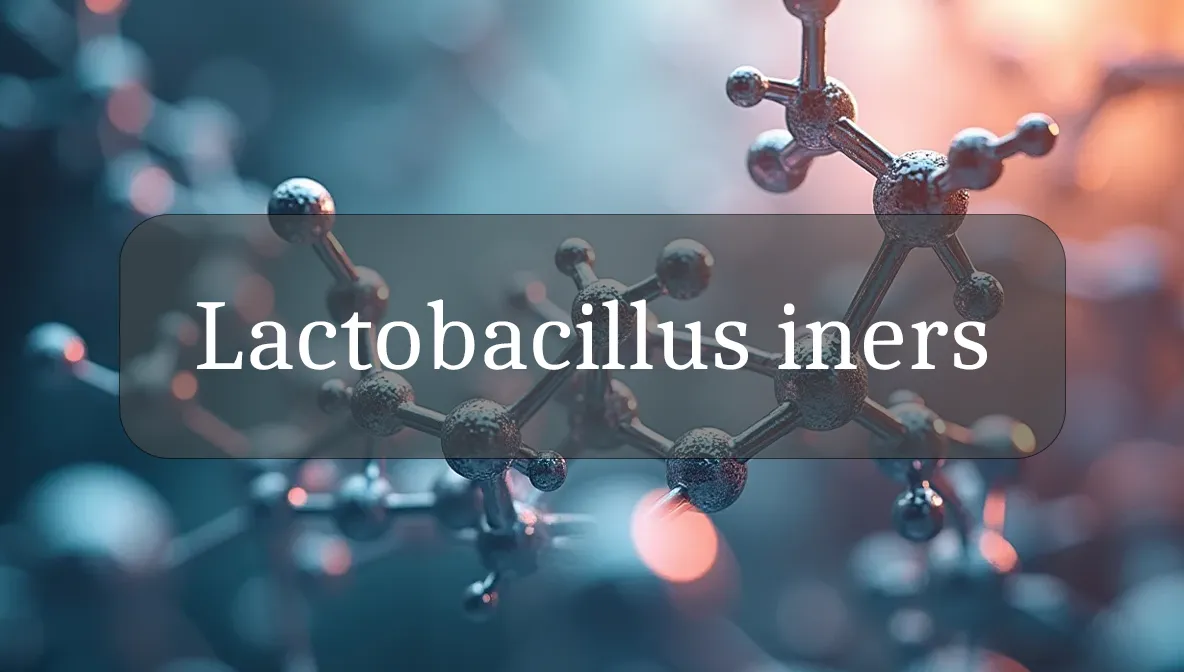Vaginal Microbiome’s Subtle Protector for Balance and Wellness
Lactobacillus iners is like a quiet guardian in the vaginal microbiome, a beneficial bacterium that helps maintain a healthy environment but is less dominant than other Lactobacillus species. Found naturally in the vaginal mucosa, it’s a key focus for health-conscious folks aiming to support reproductive health and overall vitality. Understanding L. iners can empower you to make choices that promote a balanced vaginal ecosystem. Let’s explore what L. iners is, why it matters, and how you can nurture its role for daily wellness!
Chemical Identity and Type
Lactobacillus iners is a Gram-positive, rod-shaped bacterium, a facultative anaerobe that thrives in the low-oxygen environment of the vaginal mucosa. Unlike other Lactobacillus species, it produces primarily D-lactic acid (rather than L-lactic acid) and lacks some antimicrobial defenses like hydrogen peroxide production. Found predominantly in the vagina and sometimes the gut, it contributes to an acidic vaginal pH (3.5–4.5). Think of it as a delicate gardener, supporting vaginal health but more vulnerable to disruptions than its robust cousins like L. crispatus.
Biological Role and Benefits
L. iners is a common but less protective member of the vaginal microbiome, offering these benefits when balanced:
- Vaginal pH Regulation: It produces lactic acid, helping maintain an acidic vaginal environment that discourages pathogens like Gardnerella vaginalis or Candida.
- Microbiome Stability: L. iners contributes to microbial diversity, acting as a transitional species in the vaginal ecosystem, especially during hormonal shifts.
- Pathogen Inhibition: Though less potent than other Lactobacillus species, it competes with harmful microbes, reducing infection risk.
- Adaptability: Its ability to survive in fluctuating conditions (e.g., menstruation, pregnancy) supports microbiome resilience.
However, L. iners is less effective at preventing dysbiosis than L. crispatus and may coexist with pathogens in bacterial vaginosis (BV), making its balance critical.
Dietary or Natural Sources
L. iners is a naturally occurring bacterium in the vaginal and gut microbiomes, not sourced directly from food. You can support its presence and vaginal health with these nutrient-rich choices:
- Probiotic-Rich Foods: Yogurt, kefir, and fermented foods (e.g., sauerkraut, kimchi) with Lactobacillus strains promote overall microbiome health, indirectly supporting L. iners.
- Prebiotic-Rich Foods: Garlic, onions, bananas, and asparagus feed beneficial bacteria, fostering a healthy vaginal environment.
- Vitamin D-Rich Foods: Fatty fish, egg yolks, or fortified foods (or 10–30 minutes of sunlight exposure) support mucosal immunity, aiding L. iners function.
- Antioxidant-Rich Foods: Berries, leafy greens, and green tea reduce inflammation, promoting a balanced vaginal microbiome.
A balanced diet with probiotics and prebiotics supports a healthy vaginal microbiome, encouraging L. iners stability.
Signs of Imbalance or Dysfunction
A decline or overgrowth of L. iners (often linked to hormonal changes, antibiotics, or microbiome shifts) may contribute to dysbiosis, showing up as:
- Bacterial Vaginosis (BV): Thin, grayish-white discharge with a fishy odor, itching, or burning, as L. iners may fail to suppress pathogens like Gardnerella vaginalis (BV affects 20–40% of women globally).
- Increased Infection Risk: A L. iners-dominant microbiome is less protective, raising susceptibility to yeast infections or STIs (e.g., HIV, chlamydia).
- Vaginal Discomfort: Irritation, dryness, or mild inflammation from an elevated vaginal pH (>4.5).
- Pregnancy Complications: L. iners dominance (vs. L. crispatus) may increase preterm birth risk (2–3 times higher with BV).
- Recurrent Symptoms: BV recurrence (30–50% within 3–12 months) may involve L. iners persistence alongside pathogens.
These symptoms can have many causes, so consult a healthcare provider if they persist to explore vaginal or microbiome issues.
Supporting Optimal Levels or Function
To promote a balanced L. iners population and vaginal health, try these evidence-based tips:
- Eat Probiotic Foods: Consume yogurt or fermented foods with Lactobacillus strains (e.g., L. crispatus, L. rhamnosus) to support a robust vaginal microbiome, potentially stabilizing L. iners.
- Avoid Douching: Douching disrupts L. iners and other beneficial bacteria, raising vaginal pH and BV risk. Use mild, unscented soap for external cleaning only.
- Wear Breathable Clothing: Choose cotton underwear and avoid tight clothing to reduce moisture, creating a favorable environment for Lactobacillus species.
- Limit Antibiotics: Use antibiotics only as prescribed, as they can reduce L. iners and promote pathogens. Consider probiotics during antibiotic use, with medical guidance.
- Manage Hormones and Stress: Balanced estrogen (via diet or medical support) and stress reduction (e.g., yoga, meditation) support L. iners and microbiome health.
Small, consistent habits foster a Lactobacillus-rich vaginal microbiome, keeping L. iners in balance.
Safety, Interactions, and Precautions
L. iners is a beneficial bacterium but less protective than other Lactobacillus species, so consider these factors:
- Microbiome Vulnerability: L. iners is less effective against pathogens, and its dominance may signal a transitional or unstable microbiome, increasing BV risk.
- Probiotic Supplements: Oral or vaginal probiotics with L. crispatus or L. rhamnosus may outcompete L. iners for better protection, but evidence for L. iners-specific probiotics is limited. Consult a healthcare provider.
- Hormonal Influences: Menstruation, pregnancy, or menopause can shift L. iners levels due to changes in glycogen or pH. Hormone therapy may help, under medical guidance.
- BV Recurrence: L. iners often persists in BV-prone microbiomes, contributing to recurrence (30–50% after treatment). Metronidazole or clindamycin may be needed, but resistance occurs in 20–30% of cases.
- Allergies or Sensitivities: Probiotic supplements may cause mild bloating or irritation in rare cases. Choose high-quality, tested products.
Supporting L. iners involves promoting a diverse, Lactobacillus-dominant microbiome and avoiding disruptions.
Fun Fact
Did you know L. iners is a bit of a minimalist? Unlike other Lactobacillus species, it has a smaller genome and relies heavily on vaginal glycogen, making it a unique, low-key player in your microbiome!
Citations
- National Institutes of Health (NIH): Vaginal Microbiome and Lactobacillus Species.
- Centers for Disease Control and Prevention (CDC): Bacterial Vaginosis Overview.
- Mayo Clinic: Vaginal Health and Infections.
- Cleveland Clinic: Nutrition and Women’s Wellness.
- World Health Organization (WHO): Diet and Reproductive Health Guidelines.

